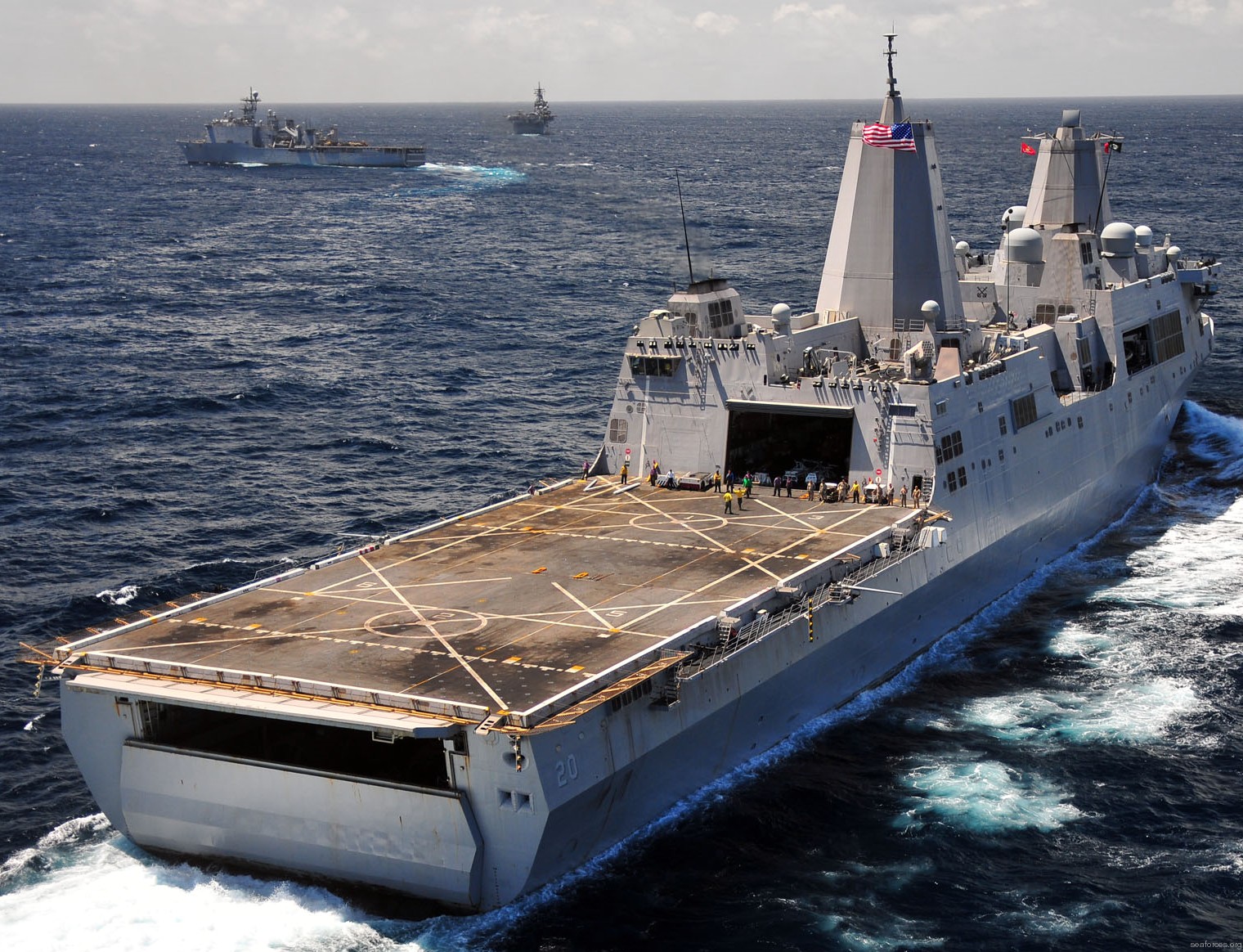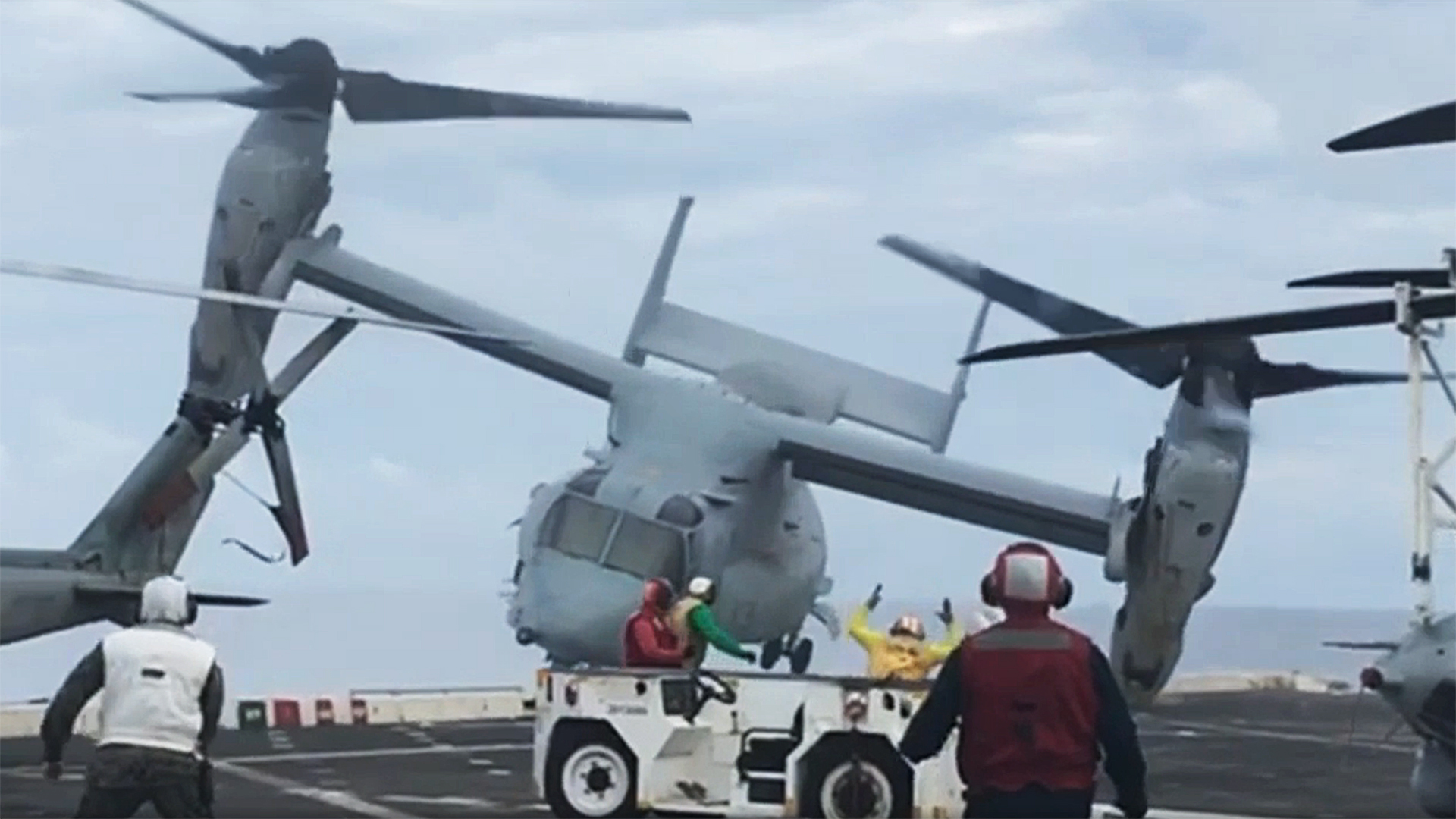A video has been posted online of the crash of an MV-22B Osprey from Marine Medium Tiltrotor Squadron 265 that was trying to land on USS Green Bay (LPD-20) while the ship was operating near Queensland, Australia on August 5th, 2017. To our knowledge, this video has not been seen publicly before. The scene it depicts is a terrifying one. The aircraft seems to be approaching the crowded flight deck of the San Antonio class amphibious transport dock ship normally when it suddenly drops, smacking its left engine nacelle onto the deck while pitching and banking dramatically. The sailor recording the landing from around the ship’s hangar bay realizes just how bad the situation has become and takes off running before it cuts off.
The video was posted on the What You Haven’t Seen Youtube channel within the last 24 hours:

Helicopter — and tiltrotor — crashes on amphibious warships can be especially destructive as other aircraft are often very nearby, likely with fuel and/or weapons onboard, and the tight operating areas leave little margin for error. The Osprey is carrying fuel and if rotor blades hit the deck or any other object they turn into large pieces of high-speed shrapnel that can cut a person — or aircraft — in half.
This terrible event ended up killing three and injuring 23.

On May 21st, 2018, USNI News published a report about the crash investigation board’s findings, stating, in part:
The investigation outlines a complex but low-risk mission. The Marine Corps determined the aircraft crashed due to facing too much downwash and not having the thrust to hold its hover, but the aircraft may also have been carrying too much weight, a Defense Department official told USNI News. Naval Air Systems Command engineers have since looked at the effect of the downwash on a landing aircraft and the amount of power the Osprey needs to overcome that downwash and land safely, and have since made some adjustments regarding how much weight an Osprey may carry on approach to a U.S. ship at sea to ensure it has the power it needs to land, the official said. The investigation report makes clear that no one was at fault in the incident and that all three personnel died in the line of duty and not due to misconduct.
The Osprey was part of a three-aircraft formation involved in a busy day of a simulated embassy reinforcement, non-combatant evacuation mission, mass casualty drill and logistics movements. On the day of the crash, the mishap Osprey flew from amphibious assault ship USS Bonhomme Richard (LHD-6) to the shore at Raspberry Creek to insert embassy reinforcement personnel, back to the ship to refuel, to nearby USS Ashland (LSD-48) to deliver cargo and a passenger, back to Bonhomme Richard, participated in a mass casualty drill while aboard the ship, delivered mass casualty personnel ashore to Raspberry Creek, returned with other passengers back to Bonhomme Richard, made one more run to Raspberry Creek and back to the big-deck amphib, and then finally made its last trip to Raspberry Creek to pick up non-combatant evacuation personnel before heading to Green Bay, where the fatal mishap occurred.
As the Osprey approached Green Bay, it initially had trouble connecting to the ship’s Tactical Air Navigation signal and so received guidance from the ship’s air traffic controllers. Upon final approach, the Osprey switched its radios to the launch and land frequency. It was set to land in Spot 5 on Green Bay and followed correct procedures to do so, according to the report.
The pilot, whose name is redacted from the report but USNI News understands was a Marine major, “recognized and attempted to correct a 200-300 foot per minute rate of descent with an application of power using the Thrust Control Lever,” the report said of the aircraft’s drop in altitude as it approached the flight deck. The pilot and copilot – 1st Lt. Benjamin Cross, who died in the crash – could not stop the descent and took several actions, including moving the Osprey’s nacelles forward. The left nacelle struck the Green Bay flight deck, and the Osprey moved forward along the starboard side of the flight deck until the plane hit a steel stairway. The left proprotor blades damaged the flight deck and a nearby helicopter, and the impact of the collision crushed the cockpit, breaking the hip and leg of the pilot inside. The aircraft then fell 30 feet into the water, and with a hole in the cockpit, the aircraft filled with water rapidly and sank nose-first.
USNI News’ report goes further into the findings of the investigations and how Osprey operations were adjusted after, as well as the incident’s similarity to a less severe mishap that occurred onboard USS New Orleans two years prior. Give the whole story a read here.
It is something of a miracle that all but three souls aboard such a densely packed Osprey were able to survive the crash. Still, their deaths, to no fault of their own, are terribly tragic. Those who died were:
1st Lt. Benjamin Cross, 26, of Oxford, Maine. Cpl. Nathaniel Ordway, 21, of Sedgwick, Kansas. Pfc. Ruben Velasco, 19, of Los Angeles.
While the Osprey has had a successful career after a very tumultuous and protracted development, the tilt-rotor still has its detractors. As far as MV-22 crashes go, just last month a Marine Osprey crashed near El Centro, California, killing all five onboard. Another MV-22 crash occurred in Norway in March, killing four. But the fact that hundreds of these Marine aircraft, and their Air Force counterparts, are out there every day operating in the most challenging environments imaginable without making negative headlines, is a testament to just how far the Osprey program has come.
Above all else, this video serves as a stark reminder of just how fast things can go from normal to catastrophic when it comes to rotary-wing operations, especially in the highly challenging maritime environment. While it may just be business as normal for them, brave men and women are out there every day doing this incredibly challenging work that is anything but without risk.
A big thank you to all of them on this 4th of July weekend.
Editor’s note: Updated text to reflect that it was first posted on the What You Haven’t Seen Youtube channel.
Contact the author: Tyler@thedrive.com
